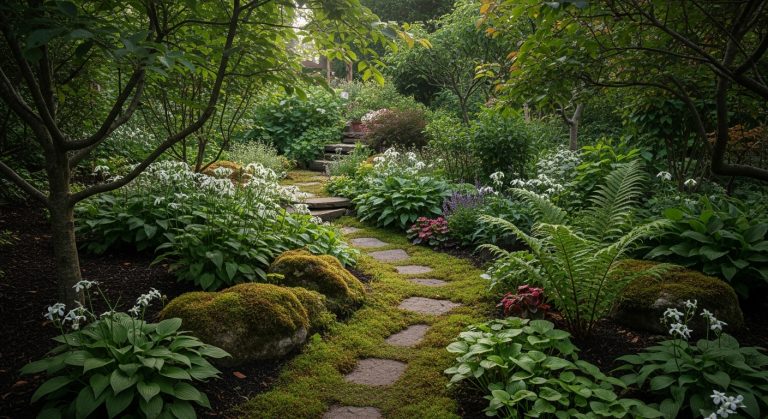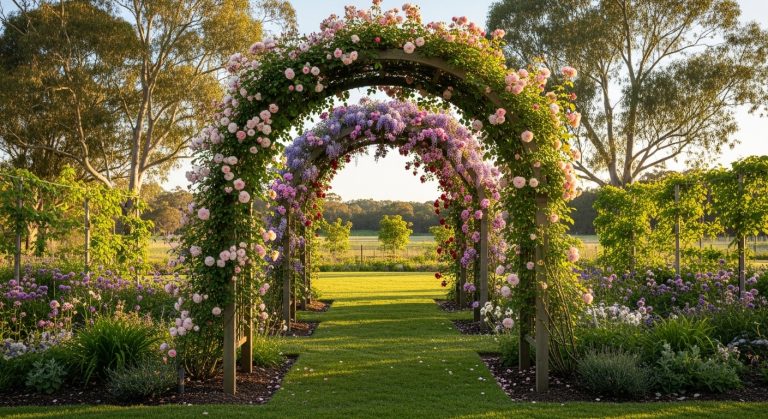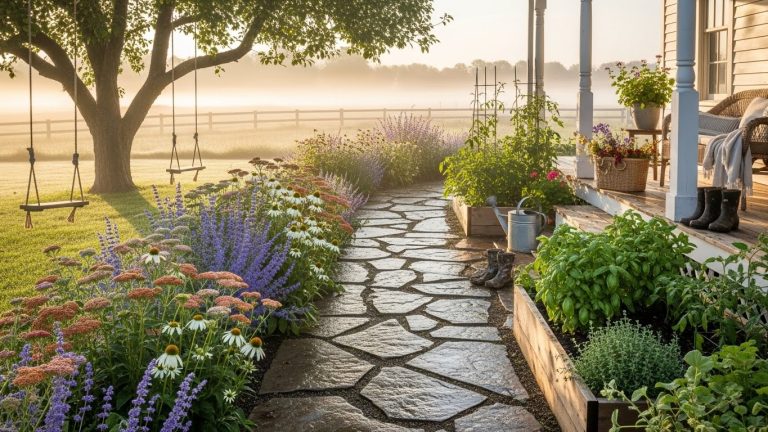Medieval Garden Design: 15 Timeless Ideas to Bring History Into Your Yard
Imagine stepping into a quiet corner of your yard and feeling like you’ve walked into an old abbey garden from centuries past—stone paths, aromatic herbs, a tucked-away fountain, and that sense of sanctuary. That’s exactly why I love medieval garden design — it’s not just nostalgia, it’s about creating a space that feels calm, rooted, and a little mysterious. I discovered this when I visited an early monastic garden recreation and realized how simple design choices (walls, beds, herbs) completely changed the atmosphere of the space.
Why does this topic matter now? More than ever, our outdoor spaces are sanctuaries. With modern life so busy, pulling design cues from the past—like the gardens cultivated between the 5th and 15th centuries—gives us structure, meaning, and the chance to reconnect with nature almost instinctively. Experts note that medieval gardens used enclosure, mixed planting, and symbolic layouts as key elements.
So if you’ve got a patch of land, a courtyard, even a terrace longing for character, these 15 ideas will give you practical, meaningful ways to apply medieval garden design today. Ready? Let’s explore.
1. Enclosed “Hortus Conclusus” Garden Spaces

In medieval times, gardens were often walled or hedged to create a sense of protection and privacy—what they called a hortus conclusus. It’s like the garden becomes its own little world.
Pros:
- Emphasises seclusion and calm—great for quiet reflection.
- Helps create micro-climates: walls or hedges can shelter plants and create warmer zones.
- Offers structure: borders, walks, and edges feel intentional and ordered.
Cons:
- Building walls or heavy hedges costs time, money or effort.
- If too enclosed, the space might feel cramped or dark rather than serene.
Takeaway:
If you want your garden to feel like a refuge, go with enclosure—it sets the tone immediately. IMO, it’s one of the most powerful design statements you can make.
2. Geometric Layouts and Quadrants

Medieval monastic gardens often used four-quadrant layouts, crossed by paths, with planting beds in rectangles. This geometry conveyed order and purpose.
Pros:
- Gives clarity and definition: the garden has zones you can see and understand.
- Easy to manage: beds and paths are distinct, which helps with maintenance.
- Visually striking: the grid or quadrant layout stands out.
Cons:
- May feel too formal for casual gardens unless softened.
- Straight lines and sharp corners can contrast with natural plant forms (which are often more relaxed).
Takeaway:
Geometry doesn’t have to mean boring—in medieval garden design it meant structure & purpose. Use straight paths and right angles, then soften with lush planting for contrast.
3. Mixed Functional Planting: Herbs, Vegetables & Flowers

One of the key traits of medieval gardens was mixing the useful (herbs, vegetables, medicinal plants) and the ornamental (flowers) in the same space.
Pros:
- Maximises utility: you get beauty and harvest.
- Historically accurate: the Middle Ages valued plants for multiple roles (medicine, food, scent).
- Year-round interest: edible crops and herbs provide seasons of change beyond flowers.
Cons:
- Codevelopment: you must consider different soil, sun, and watering needs in one bed which adds complexity.
- Less purely ornamental: If you lean toward function, you might trade some “wow” bloom for usable plants.
Takeaway:
A medieval garden blends beauty and purpose. When you grow herbs side-by-side with roses or simple flowers, your space feels richer and more alive.
4. Central Water Features or Fountains

Medieval texts indicate that monastic and castle gardens often included water – a symbol of life, purity, and calm.
Pros:
- Instantly adds a focal point and sense of calm.
- Water features attract wildlife (birds, butterflies) and create sound for ambience.
- Historically appropriate: fits the medieval theme authentically.
Cons:
- Installation and maintenance cost: pumps, cleaning, leaks.
- Safety risk in some gardens (especially where children or pets roam).
Takeaway:
Add a simple fountain, pond, or water basin—even a small one— and your medieval garden design truly feels grounded and timeless.
5. Raised Beds and Turf Seats

Raised beds (or raised planting areas) and turf benches were common in medieval garden design, especially in cloisters and abbey grounds.
Pros:
- Easier planting and maintenance: better drainage, defined edges.
- Elevated features provide vantage and design interest.
- Seating built into the garden invites slower enjoyment rather than just quick visits.
Cons:
- Building raised beds and benches can be labour-intensive.
- If built too purely, the raised structures may dominate the plants rather than compliment them.
Takeaway:
Create raised beds and seating zones to echo medieval style—with function and aesthetic combined.
6. Wattle Fences, Hedges & Protective Boundaries

Medieval gardens frequently used woven wattle fences or high hedges to enclose gardens, protect plants from animals and define spaces.
Pros:
- Clearly defines zones and boundary: gives your garden “rooms”.
- Works with natural materials: wood, willow, hedge just feel more organic and grounded.
- Provides shelter: hedges can protect from wind or create micro-zones.
Cons:
- Wattle fences require regular upkeep (reweaving, repair).
- High hedges may block views or make the garden feel closed off if not done thoughtfully.
Takeaway:
Use natural boundaries to shape your medieval garden. A woven fence or high hedge sets tone and structure at once.
7. Herbaceous Borders with Medicinal & Decorative Plants

Decorative flower beds plus medicinal herb plots were side-by-side in medieval gardens. When you grow roses, violets, lilies, alongside sage, hyssop, and lavender, you capture a living history.
Pros:
- Dual purpose: both beautiful and useful.
- Diverse textures: mixing herbs and flowers adds planting variety.
- Multisensory effect: fragrance, foliage, bloom, and utility.
Cons:
- Some herbs may overshadow or require more space than you expect.
- Maintenance: pruning, harvesting herbs adds labor.
Takeaway:
Merge ornamental and medicinal plants in your border and your garden becomes part history, part daily resource—and all inviting.
8. Fruit Trees and Orchard Areas

In the Middle Ages, orchards formed key parts of gardens and estates, offering both food and structure.
Pros:
- Adds height and vertical interest: trees lift your garden into a different scale.
- Food-producing: apples, pears, cherries bring harvest and joy.
- Seasonal change: blossoms in spring, fruit in summer/autumn.
Cons:
- Tree planting is long-term: you might wait years for full blooms or fruit.
- Maintenance: pruning, pests, cleaning fallen fruit can add work.
Takeaway:
Add a small fruit tree or two to your medieval garden and you’re not just planting a garden—you’re planting time.
9. Garden Ornamental Features: Arbours, Pergolas, Benches

Designers of the Middle Ages often built arched walkways, pergolas covered with vines, shady arbours, and stone benches to create secluded corners.
Pros:
- Creates “rooms” of the garden: places to sit, reflect, enjoy.
- Adds architecture: contrast of plants and structure gives richness.
- Provides shade and interest through seasons.
Cons:
- Erecting pergolas or arbours costs materials or labor.
- If neglected, structures can look heavy or overpower the garden plants.
Takeaway:
Use structured elements thoughtfully—arbour, pergola, seat—to let medieval garden design invite leisure, not just planting.
10. Medicinal & Kitchen Garden Zones

Medieval gardens didn’t separate beauty from utility—they included spaces for food, herbs, medicines and flowers all in one composite.
Pros:
- Practical use: you grow something you can eat or use.
- Connects you to historical traditions: your garden becomes a little living textbook.
- Rich ecological benefit: herbs attract pollinators, improve garden health.
Cons:
- Requires more thoughtful plant selection and spacing.
- Mixing utility with aesthetics can blur design if you don’t define zones clearly.
Takeaway:
If you want a garden that’s alive, functioning, and beautiful, include a medicinal/kitchen section—it feels authentic and deeply satisfying.
11. Meandering Grass “Mead” Areas & Wildflowers

Rather than tightly trimmed lawns, some medieval texts describe grass meadows with scattered flowers (millefleur) or turf seats amidst flowering lawn.
Pros:
- Soft, relaxed feel—less formal, more natural.
- Encourages biodiversity: wildflowers, grasses, insects.
- Works well in large or small spaces as a break from strict beds.
Cons:
- Requires letting go of perfect lawn standards (which may trouble perfectionist gardeners).
- Can look messy if not managed thoughtfully.
Takeaway:
If you crave relaxed beauty and a little wildness, a meadow-style grassy zone brings medieval garden design alive in modern gardens.
12. Use of Symbolic and Decorative Plants

In medieval gardens, plants often held symbolic meaning (rose for Mary, lily for purity, etc.) and the act of planting itself carried meaning.
Pros:
- Adds depth: your garden becomes more than decoration—it becomes meaningful.
- Connects you to tradition: invoking plants used for fragrance, rituals, significance.
- Great for storytelling: you can label plants, learn about them, engage guests.
Cons:
- Symbolism might feel less relevant in purely modern contexts unless you lean into it.
- Some symbolic plants may have particular needs (soil, climate) which limit usability.
Takeaway:
Choose plants knowing their story — when your garden has meaning, it becomes more than pretty, it becomes memorable.
13. Water Management: Fish Ponds, Stew Ponds & Streams

Medieval gardens often included water not just for beauty but for utility—fish ponds, stew ponds, channels for renting, symbolic reflections.
Pros:
- Adds movement and life: water attracts wildlife, creates sound and atmosphere.
- Historical accuracy and texture: evokes the layered garden designs of old.
- Cooling effect in summer: water helps moderate temperature, adds comfort.
Cons:
- Higher complexity: requires water supply, lining, cleaning, safety.
- Maintenance intensive: ponds can become muddy, need filtration or cleaning.
Takeaway:
If you’re up for the effort, a water feature rounds off your medieval garden design in both form and function.
14. Multi-Use Zones: Pleasure Gardens, Utility, Relaxation

Medieval gardens balanced utility (food, herbs) with pleasure (flowers, socialising). Your design can reflect that multi-use nature.
Pros:
- Encourages broader engagement: you grow, you relax, you invite company.
- Makes sense of space: rather than “just a flower bed,” your garden has purpose.
- Sustainable: by combining functions you reduce waste and maximise utility.
Cons:
- Design discipline required: combining uses in one space can tip into chaos if not planned.
- Maintenance can be higher: more variety means more tasks.
Takeaway:
Embrace the multifunctional spirit of medieval gardens. When your garden is used for many things, it rewards you in many ways.
15. Incorporating Modern Interpretation of Medieval Style

Finally, taking inspiration from medieval gardens doesn’t mean full reconstructions—it means bringing in elements in a modern way (materials, scale, planting) while retaining the vibe.
Pros:
- Flexibility: You can adapt to your budget, space, and climate.
- Blend of tradition + modern: your garden feels historic but lives as a contemporary space.
- Storytelling: you give your garden a heritage feel which many modern gardens lack.
Cons:
- Risk of pastiche: if you pick too many “medieval props” you might end up with a theme-park look rather than authentic charm.
- Material compatibility: modern materials may clash with old styles unless chosen carefully.
Takeaway:
Take medieval garden design as inspiration, not strict template. A few guiding elements can transform your outdoor space without overwhelming it.
Conclusion
There you have it—15 rich ideas to bring medieval garden design into your outdoor space. From the walled hortus conclusus to mixing herbs and flowers, from water features to symbolic planting, the Middle Ages offer a treasure trove of garden wisdom. For me, the special thing about this style is how grounded it feels—you’re building structure, meaning and serenity, not just decoration.
My favourite? Creating a small enclosed space with a stone bench beneath climbing roses and herbs, where you can sit and feel centuries of garden tradition around you. That kind of atmosphere is priceless.
Now take the elements that speak to you—walls, arches, herbs, water, mixed planting—and build your own version of a medieval sanctuary. Your modern garden will thank you for it.

William Martin is a passionate bowler who spends most of his weekends playing the sport. With years of intense experience under his belt, William decided to share his knowledge by creating BOWLING OCEAN. Join me on this journey to explore the world of bowling and discover the tips and tricks to becoming a pro.






